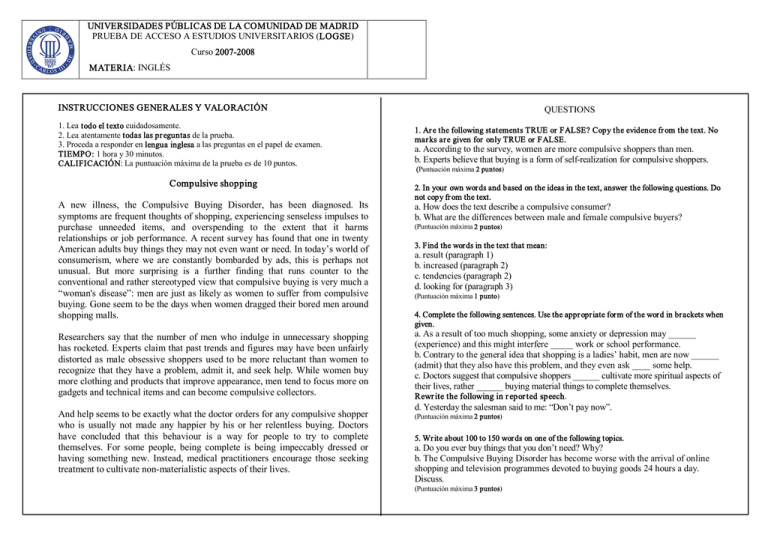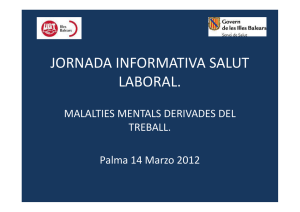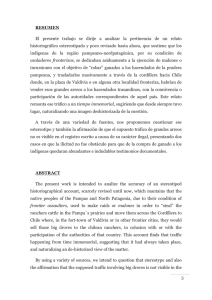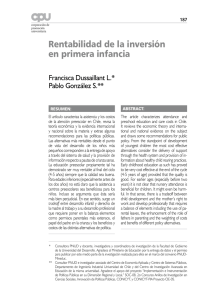Inglés
Anuncio

UNIVERSIDADES PÚBLICAS DE LA COMUNIDAD DE MADRID PRUEBA DE ACCESO A ESTUDIOS UNIVERSITARIOS (LOGSE) Curso 2007­2008 MATERIA: INGLÉS INSTRUCCIONES GENERALES Y VALORACIÓN 1. Lea todo el texto cuidadosamente. 2. Lea atentamente todas las pr eguntas de la prueba. 3. Proceda a responder en lengua inglesa a las preguntas en el papel de examen. TIEMPO: 1 hora y 30 minutos. CALIFICACIÓN: La puntuación máxima de la prueba es de 10 puntos. Compulsive shopping A new illness, the Compulsive Buying Disorder, has been diagnosed. Its symptoms are frequent thoughts of shopping, experiencing senseless impulses to purchase unneeded items, and overspending to the extent that it harms relationships or job performance. A recent survey has found that one in twenty American adults buy things they may not even want or need. In today’s world of consumerism, where we are constantly bombarded by ads, this is perhaps not unusual. But more surprising is a further finding that runs counter to the conventional and rather stereotyped view that compulsive buying is very much a “woman's disease”: men are just as likely as women to suffer from compulsive buying. Gone seem to be the days when women dragged their bored men around shopping malls. Researchers say that the number of men who indulge in unnecessary shopping has rocketed. Experts claim that past trends and figures may have been unfairly distorted as male obsessive shoppers used to be more reluctant than women to recognize that they have a problem, admit it, and seek help. While women buy more clothing and products that improve appearance, men tend to focus more on gadgets and technical items and can become compulsive collectors. And help seems to be exactly what the doctor orders for any compulsive shopper who is usually not made any happier by his or her relentless buying. Doctors have concluded that this behaviour is a way for people to try to complete themselves. For some people, being complete is being impeccably dressed or having something new. Instead, medical practitioners encourage those seeking treatment to cultivate non­materialistic aspects of their lives. QUESTIONS 1. Ar e the following statements TRUE or FALSE? Copy the evidence fr om the text. No mar ks are given for only TRUE or FALSE. a. According to the survey, women are more compulsive shoppers than men. b. Experts believe that buying is a form of self­realization for compulsive shoppers. (Puntuación máxima 2 puntos) 2. In your own words and based on the ideas in the text, answer the following questions. Do not copy fr om the text. a. How does the text describe a compulsive consumer? b. What are the differences between male and female compulsive buyers? (Puntuación máxima 2 puntos) 3. Find the words in the text that mean: a. result (paragraph 1) b. increased (paragraph 2) c. tendencies (paragraph 2) d. looking for (paragraph 3) (Puntuación máxima 1 punto) 4. Complete the following sentences. Use the appr opriate form of the word in brackets when given. a. As a result of too much shopping, some anxiety or depression may ______ (experience) and this might interfere _____ work or school performance. b. Contrary to the general idea that shopping is a ladies’ habit, men are now ______ (admit) that they also have this problem, and they even ask ____ some help. c. Doctors suggest that compulsive shoppers ______ cultivate more spiritual aspects of their lives, rather ______ buying material things to complete themselves. Rewr ite the following in r epor ted speech. d. Yesterday the salesman said to me: “Don’t pay now”. (Puntuación máxima 2 puntos) 5. Write about 100 to 150 words on one of the following topics. a. Do you ever buy things that you don’t need? Why? b. The Compulsive Buying Disorder has become worse with the arrival of online shopping and television programmes devoted to buying goods 24 hours a day. Discuss. (Puntuación máxima 3 puntos) INGLÉS CRITERIOS ESPECÍFICOS DE CORRECCIÓN TIEMPO: 1 hora y 30 minutos La prueba consistirá en el “análisis” de un texto de un idioma extranjero (el inglés en este caso), del lenguaje común, no especializado. A partir del texto propuesto, el estudiante realizará un comentario personal y responderá a cuestiones relacionadas con el texto, que serán planteadas y respondidas por escrito en el mismo idioma, sin ayuda de diccionario ni de ningún otro manual didáctico” (BOE n° 257). El texto contendrá alrededor de 250 palabras y su comprensión no exigirá conocimientos especializados ajenos a la materia de la prueba. La dificultad del texto estará controlada, a fin de permitir al alumno que realice la misma en el tiempo previsto. La puntuación total del examen será de 10 puntos. Al comienzo de la prueba se incluirán unas instrucciones generales para la realización de la misma en lengua castellana. El resto de la prueba estará totalmente redactada en inglés, y el alumno usará exclusivamente la lengua inglesa en sus respuestas. Valoración objetivos de cada una de las preguntas: Pregunta 1: Hasta 2 puntos. Se trata de medir exclusivamente la comprensión lectora. El alumno deberá decidir si dos frases que se le presentan son verdaderas o falsas, copiando a continuación únicamente el fragmento del texto que justifica su elección. Se otorgará 1 punto por cada apartado. Se calificará con 0 puntos la opción elegida que no vaya justificada. Pregunta 2: Hasta 2 puntos. Se pretende comprobar dos destrezas: la comprensión lectora y la expresión escrita, mediante la formulación de dos preguntas abiertas que el alumno deberá contestar basándose en la información del texto, pero utilizando sus propias palabras en la respuesta. Cada una de las preguntas valdrá 1 punto, asignándose 0,5 puntos a la comprensión de la pregunta y del texto, y 0,5 a la corrección gramatical de la respuesta. Pregunta 3: Hasta 1 punto. Esta pregunta trata de medir el dominio del vocabulario en el aspecto de la comprensión. El alumno demostrará esta capacidad localizando en el párrafo/s que se le indica un sinónimo adecuado al contexto, de cuatro palabras o definiciones. Se adjudicará 0,25 por cada apartado. Pregunta 4: Hasta 2 puntos. Con esta pregunta se pretenden comprobar los conocimientos gramaticales del alumno, en sus aspectos morfológicos y/o sintácticos. Se presentarán oraciones con huecos que el alumno deberá completar/rellenar. También podrán presentarse oraciones para ser transformadas, u otro tipo de item. Se adjudicará 0,25 a cada “hueco en blanco”, y en el caso de las transformaciones o items de otro tipo se concederá 0,5 con carácter unitario. Pregunta 5: Hasta 3 puntos. Se trata de una composición ­de 100 a 150 palabras­ en la que el alumno podrá demostrar su capacidad para expresarse libremente en lengua extranjera. Se propondrán dos opciones entre las que el alumno elegirá solo una. Se otorgarán 1,5 puntos por el buen dominio de la lengua –léxico, estructura sintáctica, etc.­ y 1,5 por la madurez en la expresión de las ideas ­organización, coherencia y creatividad.




